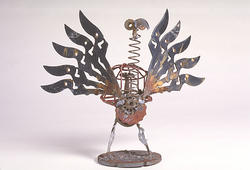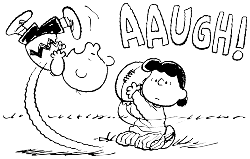 Jon Husband mentions an interesting paper by Samuel R. Smith called "Postmodernism is Dead, Now What? Distributed Culture and the Rise of the Network Age". Nice explanations of how different meta-narratives define different ages. There's not quite widespread agreement about what those ages exactly are, but it is still a very useful thing to examine. So here it goes from Modernism to Post-Modernism to the Network Age. I can go along with that, I think. In this presentation Modernism is the "Age of the Monolith". Big centralized companies and governments and ideologies. Lots of centralized stuff being built and sometimes colliding (world wars, cold war). He dates it from early 20th century to the 1960s. Next would naturally be Post-Modernism, the "Age of Deconstruction". That's more about destruction, tearing down the rigid dominant institutions and morals and norms. No longer can you have the same job for life, and the world is turning into a rather confusing place in many ways. But clearing things out can be a good thing. Jon Husband mentions an interesting paper by Samuel R. Smith called "Postmodernism is Dead, Now What? Distributed Culture and the Rise of the Network Age". Nice explanations of how different meta-narratives define different ages. There's not quite widespread agreement about what those ages exactly are, but it is still a very useful thing to examine. So here it goes from Modernism to Post-Modernism to the Network Age. I can go along with that, I think. In this presentation Modernism is the "Age of the Monolith". Big centralized companies and governments and ideologies. Lots of centralized stuff being built and sometimes colliding (world wars, cold war). He dates it from early 20th century to the 1960s. Next would naturally be Post-Modernism, the "Age of Deconstruction". That's more about destruction, tearing down the rigid dominant institutions and morals and norms. No longer can you have the same job for life, and the world is turning into a rather confusing place in many ways. But clearing things out can be a good thing."If a society stops building and begins dynamiting the foundations on which it is built, it's safe to assume that society is preparing for something more elaborate than what's being dismantled." And that next thing would be the "Network Age" since the early 90s. A new distributed social order. The Internet. Electronic bank cards. More focus on individual citizens and customers. More choices for everything.
I enjoy reading big meta stuff like that. But we could certain slice it in a number of different ways, depending what exactly we look at. And what I'm personally most interested in is what comes next. Once a network is ubiquitous and very new things emerge. Social mobs. Direct democracy. Collective life forms. We're still in an age of Confusion and Dis-continuity. I'm looking for the Integration, for what happens when things come together, according to the tune of a higher order.
[ Organization | 2003-02-19 20:51 | | PermaLink ] More >
|
 Jon Husband mentions an interesting paper by Samuel R. Smith called "Postmodernism is Dead, Now What? Distributed Culture and the Rise of the Network Age". Nice explanations of how different meta-narratives define different ages. There's not quite widespread agreement about what those ages exactly are, but it is still a very useful thing to examine. So here it goes from Modernism to Post-Modernism to the Network Age. I can go along with that, I think. In this presentation Modernism is the "Age of the Monolith". Big centralized companies and governments and ideologies. Lots of centralized stuff being built and sometimes colliding (world wars, cold war). He dates it from early 20th century to the 1960s. Next would naturally be Post-Modernism, the "Age of Deconstruction". That's more about destruction, tearing down the rigid dominant institutions and morals and norms. No longer can you have the same job for life, and the world is turning into a rather confusing place in many ways. But clearing things out can be a good thing.
Jon Husband mentions an interesting paper by Samuel R. Smith called "Postmodernism is Dead, Now What? Distributed Culture and the Rise of the Network Age". Nice explanations of how different meta-narratives define different ages. There's not quite widespread agreement about what those ages exactly are, but it is still a very useful thing to examine. So here it goes from Modernism to Post-Modernism to the Network Age. I can go along with that, I think. In this presentation Modernism is the "Age of the Monolith". Big centralized companies and governments and ideologies. Lots of centralized stuff being built and sometimes colliding (world wars, cold war). He dates it from early 20th century to the 1960s. Next would naturally be Post-Modernism, the "Age of Deconstruction". That's more about destruction, tearing down the rigid dominant institutions and morals and norms. No longer can you have the same job for life, and the world is turning into a rather confusing place in many ways. But clearing things out can be a good thing. Seb mentions a site with an excellent and comprehensive lexicon of ways to "win" in a conversation by dirty communication tricks. It would be valuable for most people to be very aware of these mind tricks so that you might be prepared, and so you might avoid the diversions others are trying to pull on you.
Seb mentions a site with an excellent and comprehensive lexicon of ways to "win" in a conversation by dirty communication tricks. It would be valuable for most people to be very aware of these mind tricks so that you might be prepared, and so you might avoid the diversions others are trying to pull on you.